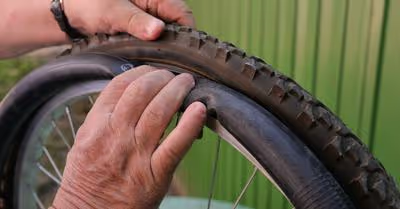
Key Takeaways
- Kitchen degreasers can be used on bike chains for effective cleaning.
- It's important to weigh the benefits against potential risks for bike maintenance.
- Use kitchen degreasers carefully to avoid damage to bike components.
Ever wondered if you can use a kitchen degreaser on a bike? Let's delve into this unconventional bike-cleaning method.
Yes, you can use a kitchen degreaser on a bike. Kitchen degreasers can break down the grease and grime that clings to your bike chain. But before you start spritzing away, it's important to understand the pros and cons to avoid any long-term damage to your two-wheeled companion.
With years of hands-on experience in cycling maintenance and household products, I can provide insightful guidance on the practicality of using a kitchen degreaser as a bike cleaning solution. My expertise ensures that I can offer a reliable source of information to help you make informed decisions about caring for your bicycles efficiently and economically. So, buckle up, and let’s explore the use of kitchen degreasers on bikes.
Can You Use a Kitchen Degreaser on a Bike?
Ever glanced at your grimy bike and the kitchen degreaser side by side and thought, "Could this be used to remove grime from the bike?"
Well, yes, you can! Kitchen degreasers are usually quite effective due to their high acidity level, which does a great job of cutting through that stubborn grease and grime on your bike.
Here’s how you can use kitchen degreasers on a bike.
- Prepare Your Workspace: Choose a suitable location for cleaning your bike, preferably in an area where it's easy to manage spills and mess. Lay out your materials within reach to ensure a smooth process.
- Apply the Kitchen Degreaser: Spray or apply the kitchen degreaser generously to the bike chain, ensuring all parts of the chain are adequately coated.
- Scrub the Chain: Use a chain cleaning tool or an old toothbrush to scrub the chain thoroughly, focusing on each link, sprocket, and derailleur pulley. The degreaser's high acidity will help break down and remove the accumulated grease and grime.
- Rinse and Wipe: Rinse the chain thoroughly with clean water to remove the degreaser and loosened grime. You can use a hose or a container of water for this purpose. Wipe the chain clean with clean rags or paper towels to remove any remaining residue.
After cleaning your bike chain with a degreaser, proper lubrication is crucial. Once the chain is clean and dry, applying a suitable lubricant is essential to ensure that your bike runs smoothly and efficiently.
This final touch guarantees a well-oiled machine that'll perform like a dream on your next ride. Below are the benefits of using a kitchen degreaser on a bike
Cost-Effective and Easy to Find
Easy Off Specialty Kitchen Degreaser
When it comes to bike maintenance, finding a solution that won't dent your wallet and is readily accessible can make a significant difference. Kitchen degreaser shines as a budget-friendly alternative that doesn't require you to splurge on specialized cycling products.
It's a practical choice that allows you to clean your bike chain efficiently without breaking the bank.
What's more, the accessibility of a kitchen degreaser is unparalleled. You can conveniently pick it up at your local supermarket or even unearth a bottle lurking in your pantry.
Non-Toxic and Biodegradable
In today's eco-conscious world, opting for non-toxic and biodegradable cleaning products has become crucial. The days of resorting to harsh chemicals are long gone, as many kitchen degreasers are formulated to be eco-friendly and safe for you and the environment.
This eco-conscious approach promotes responsible cycling maintenance and contributes to a greener planet.
Effective at Breaking Down Dirt and Grime
What sets a kitchen degreaser apart is its remarkable effectiveness in tackling the dirt and grime buildup on your bike chain. Thanks to its high acidity level, this cleaning solution effortlessly removes the stubborn grease that can hamper your chain's performance.
It doesn't stop at grease – kitchen degreaser also excels at removing debris and grit, ensuring that your chain operates smoothly.
This thorough cleaning is essential for maintaining peak cycling performance and preventing premature wear and tear.
Complementary with Other Cleaning Materials
SOFTSPUN Microfiber Cloth
Moreover, kitchen degreaser plays well with other cleaning materials you might have at your disposal.
Whether it's an old toothbrush for those hard-to-reach places or a trusty microfiber cloth for an overall shine, this versatile cleaning solution seamlessly complements your cleaning arsenal.
It integrates effortlessly into your bike maintenance routine, making the process more efficient and effective.
Simple Usage
The usage of kitchen degreaser is refreshingly straightforward. You can choose between spraying the solution directly onto the bike chain or soaking the chain in a degreaser solution.
There is no need for specialized tools or complicated equipment – just a good old-fashioned scrub with materials you likely already have at home.
This simplicity and accessibility make kitchen degreaser an ideal choice for cyclists of all levels, whether you're a seasoned pro or just starting your biking journey.
Pre-Cleaning Considerations
When you’re getting ready to clean your bike, there are a few key points to ponder before you start scrubbing. We will explore the savvy steps you need to take to prep your bike for cleaning.
Here's the deal:
Removing the Chain:
- Enables a thorough clean by allowing you to reach every link and crevice.
- Reduces the risk of degreaser getting on other components that might be sensitive to harsh chemicals, like plastic or rubber parts.
- Chain Keepers can be utilized when the chain is off, maintaining tension and making the cleaning process a breeze.
- A handy chain cleaning device can snap right onto the chain for easy on-bike cleaning if removal isn't your jam.
Leaving the Chain On:
- A quick wipe and spot treatment with a degreaser may suffice for light maintenance.
- It's less time-consuming if you're in a rush and want to spruce up the drivetrain.
- Saves you the hassle of dealing with tricky master links or requiring special tools.
If you're going for a full-on deep clean with a degreaser, I'd suggest taking the plunge and removing the chain. But if time's ticking or you're just freshening up after a dusty trail, leaving it on with a bit of a touch-up might just do the trick.
Alternatives for Cleaning and Degreasing a Bike Chain
As a cyclist, you know the importance of keeping your bike chain clean—it prevents wear and tear and ensures a smoother ride.
You can use a kitchen degreaser on your bike chain. However, there are other alternatives for cleaning and degreasing a bike, as outlined in this table:
Interaction of Kitchen Degreasers with Bike Materials
When we talk about using a kitchen degreaser on a bike, we’re mostly concerned with the drivetrain—the heart of your bike's movement system, including components like gears, chains, and cranksets.
You might imagine that if a degreaser works wonders in the kitchen, it will do the same for the bike chain coated in last week's trail dust. But here's the rub:
- Bike Chain: Your chain is made of metal that can be susceptible to rust and corrosion if not treated properly. Kitchen degreasers often have a high acidity level, which might clean the chain initially but can strip away essential lubricants, leading to increased chain wear.
- Drivetrain: Similarly, the rest of the drivetrain is precision-engineered for smooth shifts and efficient movement. Introducing a harsh kitchen degreaser into this ecosystem can cause the degradation of certain metals and plastics, removing the residue and the protective coatings.
- Bike Frame: What about the frame? While it might tolerate more robust cleaning solutions, specific materials like carbon fiber or certain paints and coatings could be damaged by the aggressive solvents in a kitchen degreaser.
- Non-toxic and Biodegradable Options: Many cyclists are moving towards environmentally friendly products. If your kitchen degreaser isn’t labeled as non-toxic or biodegradable, it could harm your bike and the environment.
So, while it’s tempting to grab that versatile kitchen cleaner, it's best to use products designed for the specific demands of your bike's materials.
Frequently Asked Questions
Here are some FAQs on using kitchen degreasers on bikes.
Are there any risks involved in using a kitchen degreaser on bike components?
Yes! Kitchen degreasers are designed with dinner plates in mind, not derailleur gears. Your bike's components are made of various materials that may be sensitive to high acidity levels typically found in kitchen degreasers.
Using them can lead to corrosion over time—or an immediate farewell to that glossy finish.
How does a bike chain cleaner and lubricant combo differ from regular degreasers?
A bike chain cleaner and lubricant combo is like the Swiss Army knife of bike maintenance: it cleans, lubricates, and protects.
Designed specifically for the tough life of a bike chain, it's less harsh than kitchen degreasers and usually comes with corrosion inhibitors and lubricating properties. Most importantly, it won't strip away essential oils that keep your chain running smoothly.
What should I consider when selecting a degreaser for maintaining my bike's frame and chain?
Look at that label. A good bike degreaser should be potent enough to cut through grime but gentle on the sensitive parts of your two-wheeled pride and joy. Avoid anything with harmful acids or alkalis that could attack the metal.






















































































































































































































































































































































































































































































































































































































































































































































.avif)
